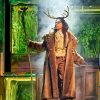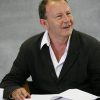The director Michael Boyd has died from cancer last week. I wanted to write something as ours has been a working relationship and friendship that has spanned over 30 years and together we have worked on 48 productions and built a couple of theatres too ! It is rare in a designer’s life to have such a long close relationship with a creative collaborator and one that has taught me so much about the nature of theatre, friendship and intellectual rigour. Michael’s approach, which grew out of his early training in Moscow, was for a total theatre in which the visual world enhanced the poetry of the actors, but never overpowered them with over conceptual thinking. That doesn’t mean our designs together were not bold, Michael was always looking for the emotional truth of the piece, stripping away any unnecessary decorative gestures. Distilling ideas so that a visual metaphor would grow in meaning as it was repeated or re-expressed throughout a piece.
He first offered me a job when I was a year out of the Slade school at the Tron Theatre in Glasgow, where he was the artistic director for ten years before his move to the RSC. My portfolio then was a mixture of realised student work and some theoretical ideas from the Slade, but I had also just spent 6 months assisting Chloe Obolensky who designed The Mahabharata with Peter Brook .(I saw that amazing trilogy of plays at the Tramway and had been so inspired I contacted Chloe , who miraculously offered me a role). I think Michael was interested in that experience with Brook, the centrality of the rehearsal space to creating and exploring work and must have seen in me the potential for an open playfulness in the process of creating a design.
My first show was Jack and the Beanstalk in a version by Forbes Masson, which threw me into the deep end of Scottish alternative theatre, followed the next year by Cinderella. Then in a move typical of Michael he asked me to do Macbeth, he didn’t pigeon hole artists into thinking they were only able to do a certain type of work. I had handled some very hands on pantos so of course was right for Macbeth. I still remember the answer machine message he left offering me the job: ‘Duncan is God , Macbeth a fallen angel, the Porter Satan and the witches will be Macduff’s dead children out of time’. The Tron is an old church, so the design worked with the building transformed it into a war damaged sacred space, complete with large shuttered windows that were opened at the death of Macbeth to let the light back in .
When Michael went to the RSC as an Associate he continued to ask me to do all his productions there in the late 90s from Broken Heart to Midsummer Nights Dream. At this time the RST was still a proscenium space and much of our work attempted to break through the fourth wall to bring the actors into the same space as the audience, to share the same air. Michael often talked about ‘the space between” actors and audience, the charged magic of theatre happens in that three way conversation between the actors and their audience, and how that was only really possible when we all shared the same room.
There is too much to say about the time at the RSC, but looking back I can see that the work was moving ever closer to creating a one room space, we experimented with the RST thrusting out, raising the stage etc , but always came up with the sightline limitations of that building. In parallel we started working on the Histories cycle. The first four plays were done in 2000 in a completely reconfigured Swan theatre, we wrapped all the wood in black (it took nearly 2 weeks to do !) And created a space virtually in the round. This production was then taken to the university of Michigan where we had to create an equivalent thrust space on a much larger scale. This gave us the confidence to think that it would be possible to really take on the RST and transform it.
When Michael became Artistic Director of the RSC in 2002 there was already plans for a redevelopment project of the theatre, but it lacked direction and a clear vision of what the theatre was for and what the company should be within it. Michael displayed his customarily clarity and directness of thought with a change of architects and a focus on budget and what the nature of the spaces should be. Up till then there had been a scheme to create a versatile main space that could reconfigure between thrust and proscenium, but this ran the risk of being a flabby space in which no one form really worked well. So we decided to develop the Theatre as a thrust stage only, within the shell of the old theatre. The worse seat went from 30 metres away to 11 metres.
He reimagined the acting company as a long ensemble of actors who would work together for up to 3 years refining their craft. The finest example of this was the Histories Company set up to do all 8 history plays in 2007/8. I had to create a design that could hold all 8 plays. Its as an amazing experience as designer to work on this huge canvas of plays, costume the same actors as they developed each new role and really feel for the first and perhaps only time in my working life fully embedded into a company and totally immersed in the work.
He supported me in becoming the Associate Designer at the RSC, believing that designers should have a place at the heart of the organisation and with that enabling me to set up the Trainee Designer scheme in 2004. In many ways I am most proud of the opportunities we gave emerging designers in the ten years of my time there.
Michael taught me that the process of design is continuous and that the deadlines that we work with are largely artificial. Models and sketches are just part of the journey and he would gleefully rip off a piece off a model or get out a spray can . They were just tools for exploration. I have kept that with me in all my working processes, never getting too obsessed with details as I know we will probably sweep it all away in the next meeting. The same was true in the rehearsal room and throughout tec and previews. Ideas that had served their time, or weren’t working had to go.
This perhaps sounds as if he didn’t respect the work that had gone into creating a design, rather it was always a positive creative challenge, this can be better , we can find a simpler way of expressing this. We would debate the ideas strongly , but with another mantra “hold on tightly , but let go lightly’,fight for an idea, but once you can see it is no longer right let it go with no regrets. He held himself to the highest standards too, legendary detailed notes sessions during previews that I know he worked on way into the night, always serving the needs of the show.
It was extraordinary to see the faith and confidence Michael held for all of us who worked with him . He nurtured so many actors, the creative and producing teams around him.Inspiring great love and affection from all, with a modesty of his own impact and influence on those around him and on the wider world through the power of the shows we made together. But above all I will miss him for the wit, friendship and the love he showed me and my family, all he taught me about the world .
Tom Piper

Michael Boyd Photograph by Ellie Kurttz








A beautifully considered and thoughtful tribute, Tom. Bravo.
This is a wonderful and moving tribute
Such a loss
The work you two did lives with me and I still often talk about the plays. Thank you for sharing such rich memories. Truly Michael Boyd influenced so many people and added to our love of the theatre.
Thanks for writing this, Tom.
Hi Tom,
We have never met, but I just read your piece on your long association with Michael and I think you encapsulate his greatest qualities and charms very well. We met up last September (on the day the Queen died though we did not know that at the time),Sitting in the NFT and on the South bank so he could enjoy a cigarette we reminisced for hours about the formative years of our designer director partnership one we had so enjoyed at the Tron and elsewhere. Tom lucky you for working together for so long with Mike for yours was a brilliant collaboration … we will remember him.
kind regards
Peter